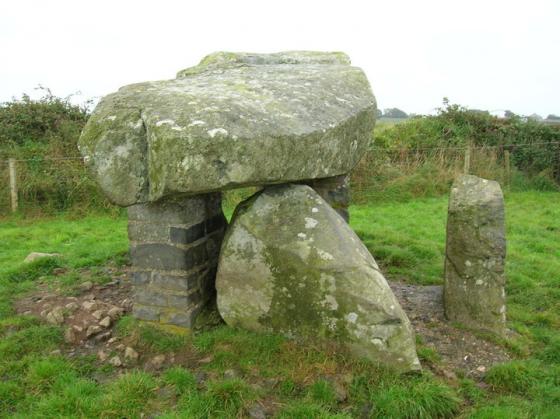The following account of its discovery was communicated, in 1821, to the Cambro-Briton (and printed in that publication, II. p. 71), by Sir R. C. Hoare, on the authority of Richard Fenton, Esq., of Fishguard.
“An Account of the Discovery, in 1813, of an Urn, in which, there is every reason to suppose, the ashes of Bronwen (White Bosom), the daughter of Llyr, and aunt to the great Caractacus, were deposited.
A farmer, living on the banks of the Alaw, a river in the Isle of Anglesea, having occasion for stones, to make some addition to his farm-buildings, and having observed a stone or two peeping through the turf of a circular elevation on a flat not far from the river, was induced to examine it, where, after paring off the turf, he came to a considerable heap of stones, or carnedd, covered with earth, which he removed with some degree of caution, and got to a cist formed of coarse flags canted and covered over. On removing the lid, he found it contained an urn placed with its mouth downwards, full of ashes and half-calcined fragments of bone. The report of this discovery soon went abroad, and came to the ears of the parson of the parish, and another neighbouring clergyman, both fond of, and conversant in, Welsh antiquities, who were immediately reminded of a passage in one of the early Welsh romances, called the Mabinogion (or juvenile tales), the same that is quoted in Dr. Davies’s Latin and Welsh Dictionary, as well as in Richards’s, under the word Petrual (square).
‘Bedd petrual a wnaed i Fronwen ferch Lyr ar lan Alaw, ac yno y claddwyd hi.‘
A square grave was made for Bronwen, the daughter of Llyr, on the banks of the Alaw, and there she was buried.
Happening to be in Anglesea soon after this discovery, I could not resist the temptation of paying a visit to so memorable a spot, though separated from it by a distance of eighteen miles. I found it, in all local respects, exactly as described to me by the clergyman above mentioned, and as characterised by the cited passage from the romance. The tumulus, raised over the venerable deposit, was of considerable circuit, elegantly rounded, but low, about a dozen paces from the river Alaw. The Urn was preserved entire, with an exception of a small bit out of its lip, was ill-baked, very rude and simple, having no other ornament than little pricked dots, in height from about a foot to fourteen inches, and nearly of the following shape [you may see the picture on the link]. When I saw the urn, the ashes and half-calcined bones were in it.






























































